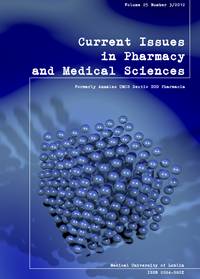Tea – natural source of fluoride compounds
DOI:
https://doi.org/10.12923/j.2084-980X/25.3/a.05Słowa kluczowe:
tea, fluorides, skeletal fluorosis, dental fluorosis, caries, dental prophylaxisAbstrakt
Tea has come to be regarded as a very popular drink, and is nowadays consumed in almost the same amounts as water. Tea has antioxidant properties, influences the organism’s antioxidant status and prevents oxidative stress. Tea constitutes a very rich fluoride source. In the paper the influence of fluorides on human organism, soft and hard dental tissues and occurrence of dental and skeletal fluorosis was discussed.
Bibliografia
1. Awadalla H.I., Ragab M.H., Bassuoni M.W. et al.: A pilot study of the role of green tea use on oral health. Int. J. Dent. Hyg. 9, 110, 2011.
2. Behrendt A., Oberste V., Wetzel W.E.: Fluoride concentration and pH of iced tea products. Caries. Res. 36, 405, 2002.
3. Cao J., Zhao Y., Liu J.: Brick tea consumption as the cause of dental fluorosis among children from Mongol, Kazak and Yugu populations in China. Food. Chem. Toxicol. 35, 827, 1997.
4. Cao J. et al.: Brick tea fluoride as a main source of adult fluorosis. Food. Chem. Toxicol. 41, 535, 2003.
5. Chan J.T., Koh S.H.: Fluoride content in caffeinated, decaffeinated and herbal teas. Caries. Res. 30, 88, 1996.
6. Chandrajith R. et al.: Fluoride in Ceylon tea and its implications to dental health. Environ. Geochem. Health. 29, 429, 2007.
7. Cressey P., Gaw S., Love J.: Estimated dietary fluoride intake for New Zealanders. J. Public. Health. Dent. 70, 327, 2010.
8. Dews P.B. (1984): Caffeine: perspectives from recent research. New York Springer Verlag.
9. Fejerskov O., Ekstrand J., Burt B.A. (1996): Fluoride in dentistry. Munksgaard Copenhagen
10. Ferrazzano G.F. et al.: Anti-cariogenic effects of polyphenols from plant stimulant beverages (cocoa, coffee, tea). Fitoterapia. 80, 255, 2009.
11. Ferrazzano G.F. et al.: Antimicrobial properties of green tea extract against cariogenic microflora: an in vivo study. J. Med. Food. 14, 907, 2011.
12. Fiedoruk A. (2004): Herbata bez tajemnic. Instytut Wydawniczy Kreator, Białystok
13. Gardner E.J., Ruxton C.H., Leeds A.R.: Black tea-helpful or harmful? A review of the evidence. Eur. J. Clin. Nutr. 61, 3, 2007.
14. Gazzani G., Daglia M., Papetti A.: Food components with anticaries activity. Curr. Opin. Biotechnol. 23, 153, 2012.
15. Izuora K. et al.: Skeletal fluorosis from brewed tea. J. Clin. Endocrinol. Metab. 96, 2318, 2011.
16. Keene M.: Domestic science: making chemistry your cup of tea. Endeavour. 32, 16, 2008.
17. Khan N., Mukhtar H.: Tea polyphenols for health promotion. Life. Sci. 81, 519, 2007
18. Künzel W.: Caries decline in Deutschland – Ursachen und Konsequenzen. Gesundheitswesen. 59, 710, 1997.
19. Larsson S.C. et al.: Coffee and tea consumption and risk of stroke subtypes in male smokers. Stroke. 39, 1681, 2008.
20. Lung S.C., Cheng H.W., Fu C.B.: Potential exposure and risk of fluoride intakes from tea drinks produced in Taiwan. J. Expo. Sci. Environ. Epidemiol. 18, 158, 2008.
21. Magalhães A.C. et al.: Chlorhexidine and green tea extract reduce dentin erosion and abrasion in situ. J. Dent. 37, 994, 2009.
22. Malinowska E. et al.: Assessment of fluoride concentration and daily intake by human from tea and herbal infusions. Food. Chem. Toxicol. 46, 1055, 2008.
23. Mukhtar H., Ahmad N.: Tea polyphenols: prevention of cancer and optomazing health. Am. J. Clin. Nutr. 71, 1698S, 2000.
24. Naderi N.J. et al.: Antibacterial activity of Iranian green and black tea on Streptococcus mutans: an in vitro study. J. Dent. 8, 55, 2011.
25. Narotzki B. et al.: Green tea: a promising natural product in oral health. Arch. Oral Biol. 57, 429, 2012.
26. Opydo-Szymaczek J., Opydo J.: Fluoride content of beverages intended for infants and young children in Poland. Food. Chem. Toxicol. 48, 2702, 2010.
27. Sikorska-Jaroszyńska M.H.J., Czelej G. (2000): Fluor w stomatologii i medycynie. Wydawnictwo Czelej, Lublin
28. Sofuoglu S.C., Kavcar P.: An exposure and risk assessment for fluoride and trace metals in black tea. J. Hazard. Mater. 158, 392, 2008.
29. Subcommittee on Fluoride (1990): Review of fluoride. Benefits and risks. Department of Health and Human Services Public, Health Service.
30. Suyama E. et al.: Remineralization and acid resistance of enamel lesions after chewing gum containing fluoride extracted from green tea. Aust. Dent. J. 56, 394, 2011.
31. van der Hoek W. et al.: Source of drinking water and other risk factors for dental fluorosis in Sri Lanka. Int. J. Environ. Health. Res. 13, 285, 2003.
32. Wei S.H.Y., Hattab F.N., Mellberg J.R.: Concentration of fluoride and selected other elements in teas. Nutrition. 5, 237, 1989.
33. Whitford G.M. (1996): Metabolism and toxicity of fluoride. Karger.
34. WHO Working Group (1984): Fluorine and fluorides. Environmental Health Criteria
35. Whyte M.P. et al.: Skeletal fluorosis from instant tea. J. Bone. Miner. Res. 23, 759, 2008.
36. Yadav A.K. et al.: Determination of exposure and probable ingestion of fluoride through tea, toothpaste, tobacco and pan masala. J. Hazard. Mater. 142, 77, 2007.
37. Yoo S., Murata R.M., Duarte S.: Antimicrobial traits of tea- and cranberry-derived polyphenols against Streptococcus mutans. Caries. Res. 45, 327, 2011.
38. Yu H., Oho T., Xu L.X.: Effects of several tea components an acid resistance of human tooth enamel. J. Dent. 23, 101, 1995.
Pobrania
Opublikowane
Numer
Dział
Licencja
Prawa autorskie (c) 2012 Autorzy

Praca jest udostępniana na licencji Creative Commons Attribution-NonCommercial-NoDerivatives 3.0 Unported License.


